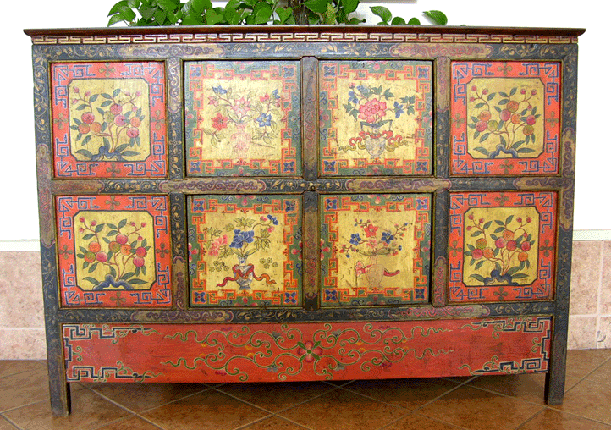
19th c, pine, mineral pigments. Authentic relic with auspicious symbols and vibrant colors, what makes Tibetan furniture stands out. 65” w. 46.½” h. 19.¾” d.
This big chest reflects what makes Tibetan furniture so desirable in a home décor. Tibetans are Buddhists and their furniture reflects religious context. Since their country is situated on a high plateau where only conifers could grow, Tibetans of old were not particular about how a piece of furniture is constructed. They love nature and color, so value of furniture to them is more in the colorful decorations and symbolisms than in carpentry technique.
This chest is composed of eight panels painted with auspicious symbols. Each of the four middle door panels has painting of a vase of peony with a ribbon tied around the vase. The peony signifies wealth and abundance and the ribbon is a prayer flag Tibetans fly everywhere, even today, in the hope their wishes will rise to their deities and get granted. Each frame member beside the door has painting of a pomegranate branch, signifying a wish for many sons. The frame member above each set of four decorated panels has the “continuous life” design, meaning a desire for long life. The rest of paintings of scroll and trailing flowering vine are all auspicious symbols, hope for wishes granted. All these designs are painted on vibrant backgrounds of yellow and orange.
The auspicious symbols painted on this chest demonstrate a “leap of faith” of the Tibetans due to trade and influence from China from the 19th century onwards. Many Tibetans became merchants. A more affluent lifestyle called for bigger homes and furniture, especially chests and cabinets that could store all their worldly belongings. Even decorating styles changed. From painting the various deities with hope of attaining enlightenment through their intervention, they now wanted auspicious symbols the Chinese favored in hope of getting more earthly wishes fulfilled.
Except for the top, which has been replaced, this chest survived a cultural revolution in good shape. The fading of paintings on a couple of panels is due to the difficulty in removing the thick layers of yak butter deposited on the surface of the painted panel for at least a century. Tibetans use yak butter for cooking and as fuel for their butter lamps which seem to be burning night and day in homes and monasteries. The faded painting shows that the piece has lived and has a history, which is what antique is about. Tibet has banned any antique from leaving the country, any available one is worth collecting.